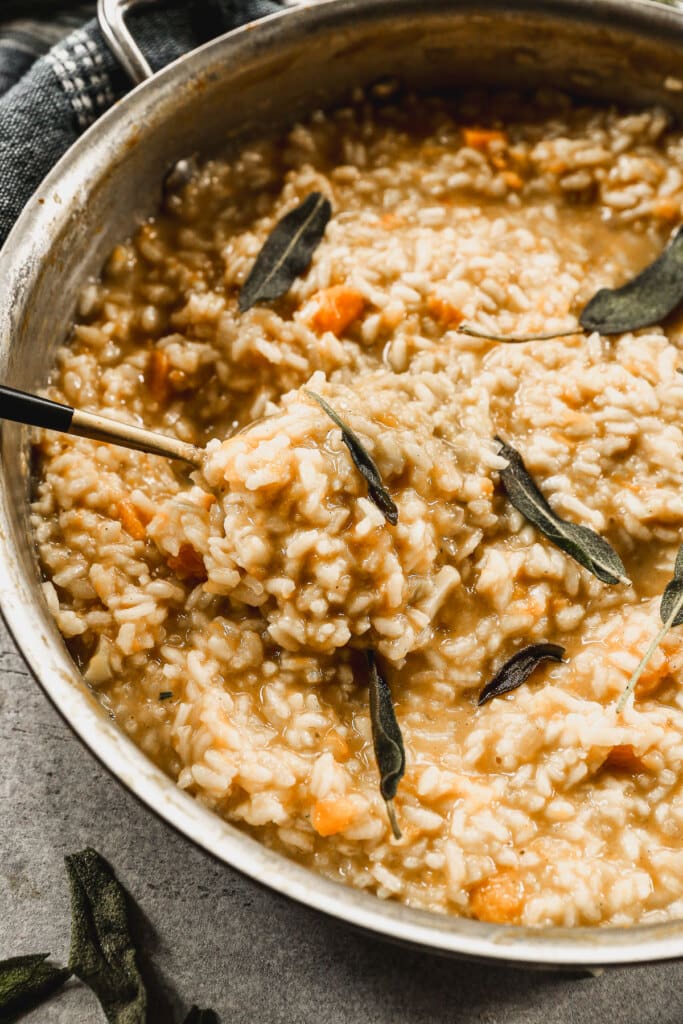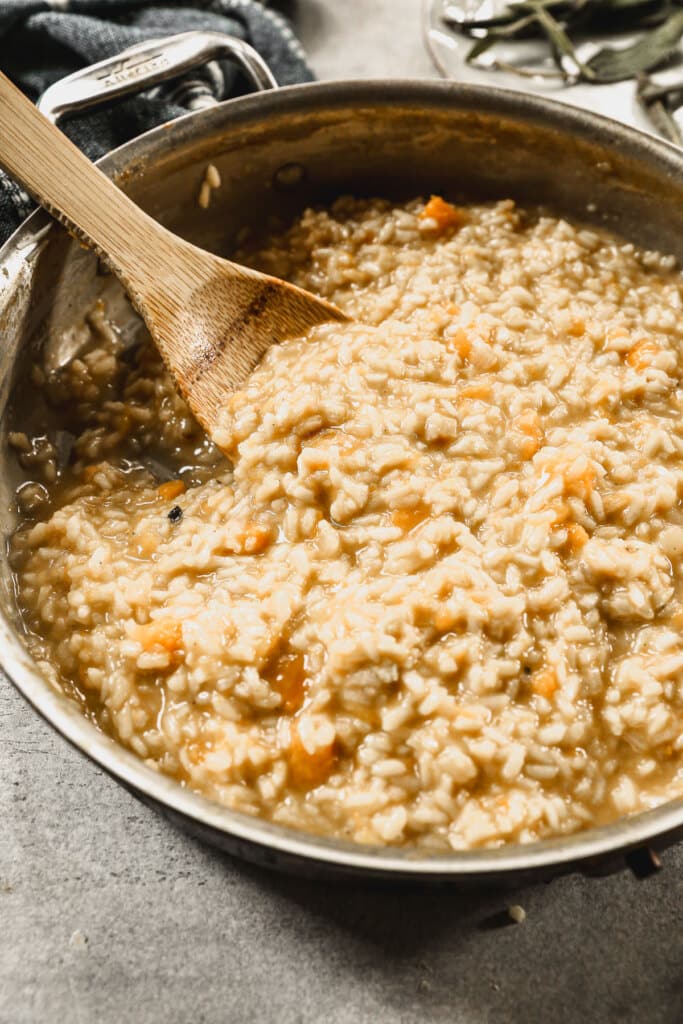This post may contain affiliate links. Please read my disclosure policy.
Brown butter laced, irresistibly creamy and brimming with sweet fall flavor, our Butternut Squash Risotto is an easy but impressive recipe perfect for whipping up this time of year.

Butternut Squash Risotto
While I find nearly all cooking therapeutic, slow-cooking risotto (or grits) is the most serotonin-inducing dish out there. From the way you toast the rice grains to the slow methodical alternations of broth and stirring, every step is soothing. The eating part is simply the cherry on top. A very tasty cherry for sure.
Risotto was one of the more “difficult” dishes I tackled as a young kid. I can’t remember where I first tried it but it obviously stuck with me because by the age of nine or ten I was whipping it up under the supervision of my mom.
In those days it was said you must stir risotto every single second to achieve the starchy, creamy texture only achieved in restaurants. After years of testing I can assure you, this isn’t true. However you must not neglect the risotto. Stirring every 4-5 minutes in the beginning is sufficient and then as the rice releases its starch and becomes thicker you want to pay a bit more attention to it. If the rice sticks to the bottom of the pan, add more liquid and stir your heart out. Let’s get started.

Ingredients in Butternut Squash Risotto
Butternut Squash. As the name implies our risotto is heavy on the butternut squash. I like to buy it pre-cubed to save time and for me, it’s one of very few vegetables I purchase pre-cut and find to be worth the extra price tag.
Olive oil. Any olive oil will do.
Sage. We use both dried sage and fresh sage, if you only have room to buy one, let it be fresh.
Butter. Unsalted butter is what you need.
Rice. Aborio rice to be exact. Aborio rice is a short-grain rice thicker than your average white rice. It contains a significant amount of starch and when it’s slow-cooked it releases that starch to result in a luxuriously creamy rice.

Shallot. Sweeter and more mild than regular yellow onions, this is what I prefer to use but it’s not mandatory.
Garlic. Garlic isn’t traditional in risotto but I find everything is better with garlic.
White wine. White wine is a must in risotto. It gives the risotto acid and a really lovely tangy bite you truly can’t get with anything else.
Chicken broth. Use rich, low-sodium chicken broth.
Parmesan cheese. We use parmesan cheese two ways. First we grate the cheese into the parmesan at the end. Second we use the parmesan cheese rind to perfume the risotto through the whole cooking process.
Honey. I like a little hint of underlying sweetness so I love to drizzle in a few teaspoons of honey at the end.

Let’s make risotto.
Start by roasting the squash. Risotto is a simple to dish so to add depth of flavor I like to roast the squash before I add it to the risotto. Toss the cubed squash with olive oil, salt and pepper. Toss. Pop in a 425 degree oven to roast while you get the risotto started. Roast until soft and caramelized about 20-25 minutes.
Put your chicken broth on the stove. The key to a creamy risotto that doesn’t take hours is to keep the temperature up. To do this, I keep the chicken stock in a pot next to my risotto skillet just below a simmer.
Make the brown butter. For me butternut squash and brown butter go hand and hand. See here, here and here. So it only makes sense for our butternut squash risotto to start with a base of brown butter. Start by adding the butter to a large hot skillet set over medium-high heat. Let the butter melt completely and when it starts to brown on the edges start to manually swirl the pan. Keep swirling the pan until the butter turns a deep brown color and smells very nutty.

Fry the sage. Add the sage leaves to the hot brown butter, cook them for about 30 seconds, then use a slotted spoon to remove them from the butter. Drain them on paper towels and sprinkle with salt. They will become ultra crispy and utterly delicious.
Toast the rice. Add the skillet with the brown butter back to the stove. Set it over a medium-high heat. Add the rice. Cook the rice for about 2-3 minutes stirring frequently until the rice is hot and toasty.
Cook the veggies. Add the onion and garlic. Saute the veggies until they become fragrant and slightly softened, about 3-4 minutes.
Add the liquid. Start by adding the wine. Bring the mixture to a boil and reduce it to a simmer until it’s reduced by half. Ladle in 3/4 cup of the broth. Stir. Continue to simmer, stirring occasionally until the liquid has almost completely evaportated.
Continue to add broth 1/2 cup – 3/4 cup at at time, stirring frequently (but not constantly) until each addition of broth has almost evaporated.

Add the squash. When the squash is soft and caramelized add half to the partially cooked risotto mixture. Continue to stir the broth in as you were doing before. Use your spoon to sort of smash the butternut squash into a puree of sorts. You want it to melt into the risotto.
Continue adding broth and stirring until the risotto reaches an ultra creamy state and the rice is soft but has an aldente bite in the middle. You want the risotto to be VERY creamy and not sticky so if needed, add more chicken stock.
Just before serving, season to taste with salt and pepper. Stir in the parmesan cheese and honey. Sprinkle the fried sage leaves on top.

Substitutions
- swap out the shallots for whatever onions you have on hand, red will even work!
- use thyme instead of sage
- parmesan can be swapped for pecorino
- if you want the butternut squash risotto to be vegetarian use veggie stock instead of chicken stock
Tips and Tricks for Recipe Success
- Make sure your broth is warm or hot. Room temp is okay but will make your risotto take longer to cook. DO NOT use cold chicken broth.
- You do not need to stir the butternut squash risotto constantly but you do need to a babysit it just a bit. Stir every few minutes and more at the end of the cooking process. If the rice starts to stick to the bottom of the pan, you need more broth.
- Season as you go! This is so important in any recipe but especially risotto. The chicken broth is low sodium and rice is innately bland. Season the rice and veggies before adding the broth and then season as you the cooking process plays out.
- The risotto should be creamy and slightly loose not sticky. If the risotto is too thick, add more broth and make sure to season again.

Can I make risotto ahead of time?
Okay this is the best part – yes! I love to make risotto for dinner parties but I don’t want to be at the stove for 30 minutes while it cooks. Here’s what I do: I cook the risotto until it’s about 90% done and remove from the heat. Don’t add the cheese or honey yet. Turn the heat off and cover. Let the risotto sit at room temperature for up to two hours. When you’re ready to serve, bring it back up to a simmer and add the last of the chicken broth or more as needed. Add the cheese and honey. Serve.
Alternatively, you can cook it from start to finish. Spread it on a baking sheet and place in the freezer to stop the cooking process. Store in an airtight container. When you’re ready to serve, add it back to a large pot. Bring it to a simmer and then add a little bit more chicken stock to loosen it up. Season with salt and pepper.
Is risotto good leftover.
Yes yes yes.

Butternut Squash Risotto
Ingredients
- 1 tbsp olive oil
- 3 cups cubed butternut squash (I buy mine pre-cut at the grocery store.
- 2 tsp kosher salt, divided
- 1/2 tsp dried sage
- black pepper
- 3 butter
- 20 fresh sage leaves
- 1 1/2 cups aborio rice
- 1 large shallot, minced
- 2 large garlic cloves, minced
- 1 cup white wine
- 32 oz + 1 1/2 cups chicken broth
- 1 parmesan cheese rind
- 1 cup parmesan
- 2 tbsp honey
Equipment
Instructions
- Preheat the oven to 425 degrees. Pour chicken stock into a large stock pot. Bring to a low simmer. Line a large rimmed sheet pan with parchment paper. Toss the cubed squash with olive oil, 3/4 tsp salt, pepper and dried or fresh sage. Toss to coat. Place in the oven and roast while you get the risotto started. Roast until soft and caramelized about 20-25 minutes.
- Heat a large skillet with high sides to a medium-high heat. Add the butter to the hot skillet. Let the butter melt completely and when it starts to brown on the edges start to swirl the pan. Keep swirling the pan until the butter turns a deep brown color and smells very nutty. Add the sage leaves to the hot brown butter and cook them for about 30 seconds until the are fried. Use a slotted spoon to remove the sage leaves from the butter. Drain them on paper towels and sprinkle with salt.
- Add the skillet with the brown butter back to the stove. Set it over a medium heat. Add the rice. Cook the rice for about 2-3 minutes stirring frequently until the rice is hot and toasty.
- Add the onion, garlic and 1/2 tsp salt to the rice. Saute the veggies until they become fragrant and slightly softened, about 3-4 minutes.
- Add the wine to the rice and veggies. Bring the mixture to a boil and reduce to a simmer. Simmer until it's reduced by half. Use a ladle to stir in 1 cup of the broth and 1/4 teaspoon salt. Stir. with a wooden spoon. Continue to simmer, stirring occasionally until the liquid has almost completely evaportated. Add another 1/2 cup of broth, stir. Continue to add broth 1/2 cup – 3/4 cup at at time, stirring frequently (but not constantly) until each addition of broth has almost evaporated. About halfway through cooking add another 1/4 teaspoon of salt.
- When the squash is soft and caramelized remove it from the oven. Add half to the partially cooked risotto mixture. Continue to stir the broth in as you were doing before. Use your spoon to smash the butternut squash. You want it to melt into the risotto.
- Continue the process of adding broth and stirring until the risotto reaches an ultra creamy state, the chicken broth is gone and the rice is soft but has an aldente bite in the middle. You want the risotto to be VERY creamy and not sticky so if needed, add more chicken stock.
- Just before serving, season to taste with plenty of salt and pepper. Stir in the remaining butternut squash, parmesan cheese and honey. Stir to combine and season again with salt and pepper. Sprinkle the fried sage leaves on top before serving,




Leave a Comment